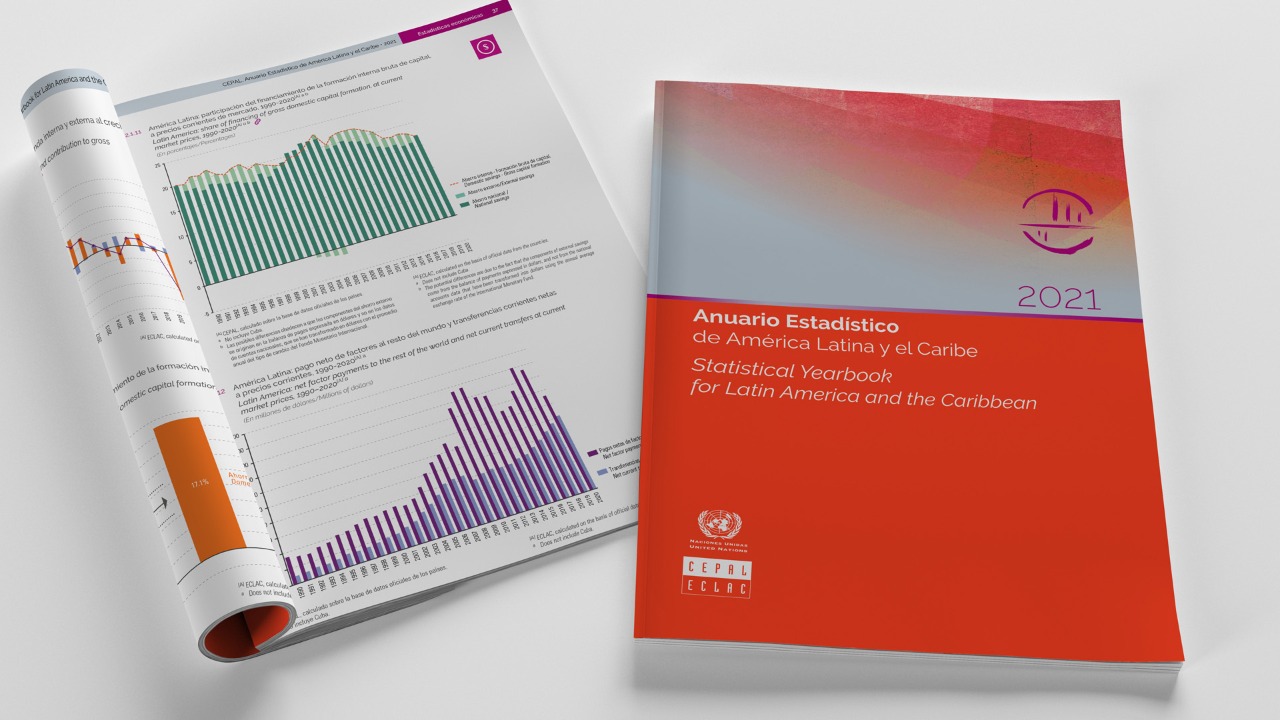New Edition of ECLAC’s Statistical Yearbook Presents Relevant Indicators on the Economic, Social and Environmental Situation in Latin America and the Caribbean
Work area(s)
The 2021 version of this publication updates a selection of key statistics on the development of the region’s countries.

The Economic Commission for Latin America and the Caribbean (ECLAC) released today the Statistical Yearbook for Latin America and the Caribbean 2021, which is available online and presents a statistical overview of the sociodemographic, economic and environmental development of the region’s countries.
This annual flagship publication, which is among the United Nations regional organization’s most important works, constitutes an important reference for those seeking comparable descriptive statistical data between countries and over time. The current edition contains information available as of mid-December 2021.
The Statistical Yearbook 2021 is divided into three chapters. The first delves into demographic and social aspects, including indicators on population, work, education, health, housing and basic services, poverty and income distribution, and gender.
In the social arena, the Yearbook’s data reveals the impact of the COVID-19 pandemic on the population’s living conditions. In 2020, poverty in Latin America affected 33.0% of the population, which includes the 13.1% living in situations of extreme poverty. These figures represent the biggest annual increase seen in the last 20 years, with a 2.5 percentage point rise in poverty and 1.7 points in extreme poverty.
The pandemic’s impact on employment could be seen in the decline in the population’s rate of participation in economic activity, which for Latin America and the Caribbean amounted to just 57.8% in 2020 versus 62.5% in 2019; as well as in a higher open unemployment rate, which went from 8.1% in 2019 to 10.5% in 2020. As a result, the population without their own income increased notably in the region, especially among people from 15 to 24 years of age.
The second chapter of the annual report presents economic information referring to national accounts, balance of payments, foreign trade and price indices, among other indicators. It points to a positive projection for a 6.3% recovery in Gross Domestic Product in 2021 (at constant 2010 prices), versus the -6.8% drop recorded at a regional level in 2020 due to the impact of the COVID-19 pandemic. These results are reflected in the average GDP per inhabitant, which amounted to $8,307 dollars in 2020 and $8,747 dollars in 2021, marking a growth rate of 5.3%.
Meanwhile, Foreign Direct Investment (FDI) in the region plunged by -20.4% in 2020 compared with 2019, with Latin America experiencing a -20.7% decline and the Caribbean down by -10%. As a percentage of GDP, FDI represented 2.1% in the same period.
In 2020, intraregional exports represented 13% of all shipments abroad. With regard to imports, intraregional purchases accounted for a 13.9% share of the total. Intraregional exports fell 8% versus 2019, while the decline in intraregional imports for the same period was 4.5%. With regard to the terms of trade, there was a slight increase of 0.2% for Latin America in 2020 as compared with 2019.
Upon analyzing the price indices for the region’s main exported products, a 28% increase is forecast for 2021, reversing the 4.9% decline recorded in 2020 in comparison with 2019.
In 2021, consumer prices rose 12.6% in Latin America and the Caribbean, without contemplating the figures from the Bolivarian Republic of Venezuela, the inclusion of which would have boosted the regional calculation to 42.1%. The biggest contribution came from the prices for food and beverage products, which rose by 12.5% (without taking Venezuela’s figure into account).
The third chapter of the Yearbook offers environmental statistics and indicators from the region. These include metrics on physical conditions; land cover; ecosystems; biodiversity; environmental quality; land; energy, water and biological resources; emissions; disasters; human settlements; and environmental regulation and governance.
It can be seen that since 1990, Latin America and the Caribbean has improved its energy efficiency, with a 26% reduction since that year in the energy intensity of GDP as a function of the primary energy supply, and a 13% decline in final energy consumption. To produce a unit of GDP (wealth), fewer units of energy were needed and thus less pressure was exerted on the environment.
The report also indicates that since 1990, the region has increased its exports of renewable and non-renewable natural resources by 168%, although the share of these primary exports (renewable and non-renewable natural resources) vis-à-vis total exports has declined by 31%. This means there is greater pressure on natural resources, which causes a negative impact on the environment.
With regard to emissions, the structural trend points to an increase in total emissions, excluding land-use change and forestry, with the energy sector accounting for the largest share of emissions.
The Statistical Yearbook is published in a print version and an online format, which include a selection of tables and graphs aimed at providing a summary of the statistical information from a regional perspective. The interactive web version facilitates navigation and access to the information presented in the print version, linking graphs and statistical tables to the data series available in ECLAC’s databases, which allows for accessing information that is more detailed and refers to a much broader historical period. It also contains an additional chapter explaining methodological aspects and specifying the references to the data sources used.
The information underpinning the Yearbook is part of the set of statistics available on CEPALSTAT, a platform that gives access to all the updated statistical information from the region’s countries that is collected, systematized and published by ECLAC. This platform was recently updated in terms of its technology and functions, including a Geoportal that enables visualizing the region’s statistics in the distinct territories.
Given that most of this information comes from national statistics offices, central banks, international bodies and other official institutions, ECLAC invites users to pay attention to the sources and the technical notes presented in this study. The data is obtained using international methodologies and standards with the aim of ensuring the greatest possible comparability between countries, which means that these figures may not necessarily coincide with national data.
Related content

ECLAC Presents the CEPALSTAT Portal’s New Interface Linking Regional Statistics and Geospatial Information on Latin America and the Caribbean
Alicia Bárcena, Executive Secretary of the UN regional commission, led the launch of the revamped portal and stressed the importance of the interoperability of information through open data.
Related link(s)
Country(ies)
- Latin America and the Caribbean
Contact
Public Information Unit
- prensa@cepal.org
- (56 2) 2210 2040